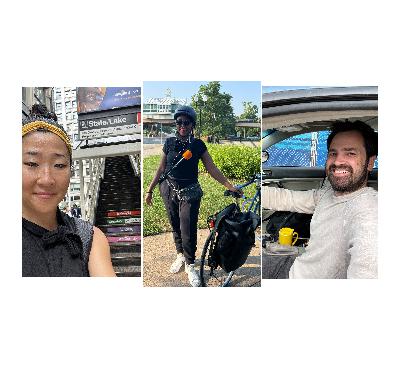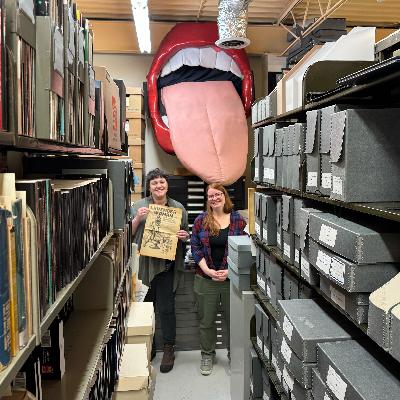Discover Curious City
Curious City

596 Episodes
Reverse
The story of Pigasus, who unknowingly accepted the Youth International Party (Yippie) nomination for president in Daley Plaza in 1968, shows that sometimes pigs need rescuing.
“My heart hurt for the pig,” said April Noga, executive director of Chicagoland Pig Rescue, of Pigasus’s run for president. “Because I put myself in the pig’s shoes of being pulled around a rally and then detained and not knowing what's going on. And used as, not entertainment but used as a prop. Because the pig is a sentient being.”
In our last episode, we dispelled a rumor that Pigasus was barbecued. Reporter Andrew Meriwether searched Grayslake and Libertyville for the farm where she lived out her days following the ‘68 campaign. In today’s episode, Noga tells us why pigs still need rescuing. She explains that Chicagoland Pig Rescue gets as many as 20 calls a month, from overwhelmed people in need of rehoming a small-breed pet pig, to concerned citizens who have spotted an injured, large-breed pig on the side of the road.
“Every case is a little different,” Noga said.
Noga explains how she started Chicagoland Pig Rescue and how pig rescuing and fostering works. She also introduces us to Ramona, a three-year old potbelly mix who was rescued from a home where she was neglected. Noga described Ramona — who is one of six pigs in Noga’s “house herd” — as an "automatic foster fail."
During the demonstrations at the Democratic National Convention in 1968, activists trotted out a pig named Pigasus for president. Her campaign was cut short after she and protesters were arrested by the Chicago Police. Rumors swirled that Pigasus was barbecued, but what really happened to her?
Curious City went out to find the oldest book in circulation at the Chicago Public Library. Turns out, the title is over 200 years old, and you can still check it out.
Summer is coming to an end, and it’s time to go back to school.
Today, the number of Chicago Public School students complaining about school lunch might only be matched by the complaints over homework assignments. So it may come as a surprise that decades ago CPS students actually looked forward to eating cafeteria lunch.
In our last episode, WBEZ’s Sarah Karp found that privatization of food services and revamped health guidelines shifted the menu for CPS students. During Karp’s reporting, many alumni kept mentioning an old lunchtime staple, the famed CPS butter sugar cookie. This was a cookie served district wide and baked fresh by lunchroom staff during the 1960s-1980s. The cookie has long been discontinued in schools, but there’s still a cult following. Dozens of copycat recipes pop up on a simple internet search, and one woman even turned it into a business.
Curious City decided to put this cookie to the test. With the help of CPS culinary instructor Jeffrey Newman and a dupe recipe, we re-created this classic lunchroom treat. Is it worth all the hype? Will current CPS students like it? Or is this merely a dose of childhood nostalgia?
Some Chicago Public School alumni say school lunch used to be delicious, which might shock current students. How did school lunch go from delicious to disappointing?
Chicago is known for crime bosses like Al Capone, but the city is also home to two Chinese gangs that were once fierce rivals. This story first aired in 2018.
A courageous Chicagoan once helped foil a robbery by men in butcher smocks — a little-known gang from a bygone era of crime in the city.
Community organizations are helping Chinatown residents preserve what long-standing family associations helped build.
Family associations were once the backbone of social and economic organization for Chicago’s Chinatown. Their evolution over the decades tells the history of the community.
What is it about softball?
“What is it not about softball?” replies Megan Faramio, a star pitcher for the Talons in the all-new Athletes Unlimited Softball League, or AUSL. “I can literally talk about softball for days.”
The AUSL is about to wrap up its first season with a three-game playoff series in Alabama between Faraimo’s Talons and the Bandits, a team name that Chicago softball fans know well. The Chicago Bandits were based mainly in Rosemont and played in the National Pro Fastpitch league from 2005 to 2019 until the league disbanded during the COVID-19 pandemic. The AUSL said it was “re-introducing” the Bandits brand “to make new history.”
AUSL league commissioner Kim Ng acknowledged that pro women’s softball leagues in the U.S. have a “spotty” history, but she says this league will be different.
In this inaugural “barnstorming season,” AUSL teams like the Talons and Bandits are not yet attached to specific cities, so The Stadium in Rosemont has hosted every team in the small league for many of the regular season’s games. Next year, the AUSL plans to attach six teams to six to-be-determined cities, and Ng says Rosemont is on the short-list.
“Absolutely, you have to consider somewhere that has a Jennie Finch Way,” Ng said, a reference to the team’s legendary former player and the street named after her where Rosemont’s pro softball field is located.
In our last episode, we looked back at Chicago’s first professional women’s softball league from the 1940s and ‘50s — one that featured business-sponsored teams like Parichy’s Bloomer Girls or Brach’s Kandy Kids. That softball league rivaled the pro women’s baseball league featured in the 1992 movie “A League of Their Own.”
Today, we’re exploring this new chapter in professional women’s softball history. What’s going to give the AUSL staying power? And what’s all the hype about?
We asked Talons star Megan Faraimo, Commissioner Ng, and — at a sellout crowd on a hot day in Rosemont — the fans.
There was the Rockford Peaches, women’s pro baseball team of the 1940s that was celebrated in the movie "A League of Their Own." But there was also a pro softball league at the time that had Chicago fans going wild.
What would win in a race between a car, bike and the Chicago Transit Authority?
Over the past few years, Chicago has been abuzz with road construction projects. There are more protected bike lanes, pedestrian refuge islands and curb bump-outs across the city. As we learned in our last episode, that also includes the installation of miniature traffic circles in residential areas. It’s all in service to make the roads safer by slowing cars down.
Safer streets is a win, but it doesn’t necessarily satisfy the urge to get somewhere fast. Cycling and public transportation are viable alternatives, but sometimes it’s hard to separate yourself from the convenience of driving somewhere.
In this episode, the Curious City team puts the different modes of transportation to the test in a good old-fashioned transit race. From the Garfield Park Conservatory to Navy Pier, who will win? Car, bike or public transportation?
Plus, Midwest correspondent for the Economist, Daniel Knowles makes the case for why we should rethink our relationship with cars, and answers why the fastest isn’t always the best.
“People will always drive if it's the most convenient or the quickest way,” said Knowles, author of “Carmeggedon: How Cars Make Life Worse and What to Do About It.” “You can't exhort people to change, you have to kind of change the incentives.”
Mini traffic circles at the intersections of residential streets might annoy drivers because they force cars to slow down. But their safety features outweigh the inconvenience.
Swami Vivekananda is credited with introducing Hinduism to the West. His work earned him an honorary street sign on Chicago’s Michigan Avenue, but it went missing.
Early LGBTQ+ history can be hard to find. Photos, letters, literature and other artifacts have been destroyed or hidden away, in acts of homophobia, out of a fear of repercussions, and even by witting and unwitting family members.
“I think a lot of LGBTQ people, when they were passing away, their materials were being destroyed by family members that didn't understand them,” said Jen Dentel, the community outreach and strategic partnerships manager at Gerber/Hart, a large LGBTQ+ library and archive in Chicago. “And so having a space by us, for us, where we would collect and preserve the history became really important.”
As we learned in our last episode, some queer women boldly operated sapphic establishments in Chicago during the 1920s and ‘30s. However, there was very little written about these places. Often, the only evidence of their existence came in the form of old newspaper articles reporting on the sudden closure of these businesses at the hands of Chicago police.
In this episode, Dentel and Erin Bell, Gerber/Hart’s operations director, take us on a tour of this LGBTQ+ library and archive. They uncover archival treasures of the past, reveal unexpected moments in local gay history and explain the mission of the archive: to preserve queer history as a means of achieving justice and equality.
It’s not hard to find the LGBTQ+ hangouts in Chicago these days, but at one point it was. There’s a history of lesbian nightlife that goes back more than 100 years.
One Curious City listener was skeptical about whether real people actually win WBEZ’s pledge drive giveaways. They do. But there’s a little more to that answer. Plus, an economist who studies fundraising explains why people give money during pledge drives in the first place.
This episode was originally published on March 3, 2022.
An on-air spot soliciting car donations is a fixture of public radio, but do people actually donate? Yes, about 50 cars are donated a month.
“Forest bathing” is the exceptionally simple Japanese practice of taking a walk — or a seat — in the woods.
Why? For your health, of course!
In our last episode, we learned about Chicago’s urban forest — including the $416 million in benefits all those trees provide, in terms of energy cost savings, stormwater mitigation and air purification. Today, we’re taking advantage of that urban forest by taking a bath in it. (And no, there is no soap or water required.)
Our guide is the co-founder of The Spiritual Guidance Training Institute, Jeanette Banashak, who’s also a faculty member at Erikson Institute downtown.
Banashak has been leading forest bathing and nature companionship experiences for four years. She took Curious City to the Jarvis Bird Sanctuary on the North Side for what she called “a playful, slow, mindful, joyful walk [and] sit in the natural world.”
The goal of forest bathing is to disconnect from urban life, de-stress and connect with nature. Banashak said the practice is rife with health benefits, from lowering blood pressure to improving immune function and calming your parasympathetic nervous system. And although the practice does not require a guide, Banashak has a dream of training facilitators of these experiences to offer weekly sessions, year-round, on every side of the city.
Lucky for us, Chicago has plenty of parks, bird sanctuaries, and natural spaces in which you can forest bathe. So join us. All you need to do is make the time and press play.
Some Chicagoans have noticed city workers cutting down seemingly healthy trees. Who is responsible, and why are they cutting down these trees?
 United States
United States








#Mahsa_Amini #Nika_Shakarami #Sarina_Smailzade #Hadis_Najafi #Dictator_Governance #Protest #Iran #مهسا_امینی #نیکا_شاکرمی #حدیث_نجفی #سارینا_اسماعیل_زاده ✌️✌️✌️